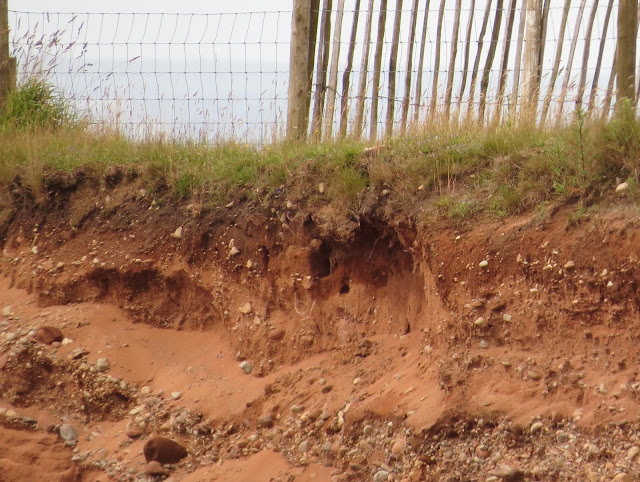With the rumour mill going in
to overdrive late on Thursday evening that two pairs of Bee-eaters were nesting
in Cumbria, an official press release was issued by the RSPB the following
morning announcing that 6 Bee-eaters were indeed frequenting Lower Gelt Quarry
up near Brampton in Cumbria, and that the first of two nests had just hatched! Having
never managed to catch up with Bee-eaters in the UK and being one of my
all-time favourite birds, there was absolutely no doubt as to where I would be
come Saturday.
Arriving just after lunch
following a two hour stretch up the M6, we followed the signs leading up to the
Bee-eater viewpoint set up by the RSPB to try and catch a glimpse of these most
colourful of visitors. Despite the warm sunny weather, we were told the pair
hadn’t been as active as the day before, swapping over nesting duties perhaps
once every couple of hours – we could have been in for a long wait!
However, luck was on our side,
and a mere 10 minutes or so after we had set up our scopes, I spotted an adult
flying in to the nesting hole, the bright yellow and aquamarine plumage
unmistakeable! Unfortunately for Alex, I was looking through his scope at the
moment of arrival (he asked me to check he was looking at the right sand bank!)
so it was with great relief that a few moments later the adult peeked its head
out of the nest hole before flying out and off over the fence.
The birds seemed to become
more frequent after this, and the adults could be seen bringing food back to
the nest and flying over the quarry every 20 minutes or so. Whilst distant (the
nest is on the opposite quarry bank around 350m away) you can get great scope
views as the birds change over and fly off over the bank, and they will often
perch on the fence post, beaks laden with bumblebee prey for the youngsters,
before they head in to the hole. Whilst the birds are not feeding over the
quarry itself (they seem to fly off over to the left) you can also get good
views from the car park, as several birds have developed a habit of perching in
the dead trees there.
 |
| Two birds together |
 |
| Bee-eater living up to its name |
 |
| Heading in to the nest hole |
Present at the quarry in
Brampton since mid-June after RSPB staff were alerted to the presence of a
number of Bee-eaters flying around with the nesting Sand Martins, it has been
established that there are 6 birds in total, with two breeding pairs (the
second nest has not yet hatched and is further along the bank). The two non-breeding
males are nest helpers (most likely to be relatives) and demonstrate the
tendency for Bee-eaters to nest colonially and undertake co-operative breeding.
Apparently two hives have been generously set up to aid feeding, and RSPB staff
have been watching around the clock to protect the nest from any potential egg thieves.
 |
| The larger hole to the left of the small round hole is the nest |
 |
| The quarry itself - the birds are nesting in the opposite bank |
Some have been put off by the
distance involved when viewing the birds, and while the Bee-eaters are not
quite dancing over heads like some clearly envisaged, it is well worth making
the trip up to see this special occurrence of breeding Bee-eaters in Britain.
Whilst the photos don’t quite do them justice, it is something magical to watch
these rainbow coloured marvels dart across British skies.
 |
| The Bee-eater trail signs! |
With Bee-eaters nesting
successfully in the Isle of Wight last year and raising 8 young between 2 pairs,
there is talk as to whether this vibrant visitor from the Mediterranean may
eventually colonise the UK. With such an influx of Bee-eaters this spring and
with several flocks of 10 birds seen (like the popular flock in Suffolk) it was
most probably inevitable that some would stay and breed this year. Prior to the
previous year’s Isle of Wight nests, the last successful breeding was at Bishop
Middleham Quarry back in 2002 (a Herefordshire nest in 2005 was sadly predated
by foxes) and with the last successful fledging before then being in 1955,
there was a huge gap of 47 years in between! Only time will tell if this will
become a regular occurrence in Britain, but I for one would definitely welcome
regular breeding Bee-eaters to our shores with open arms!
 |
| Bee-eaters in Spain - hopefully flocks like this will become a more regular sight in Britain |










No comments:
Post a Comment